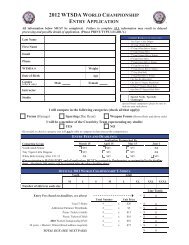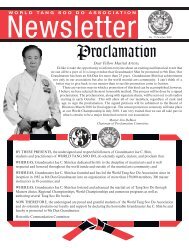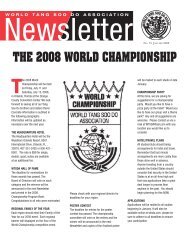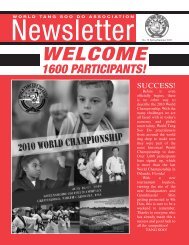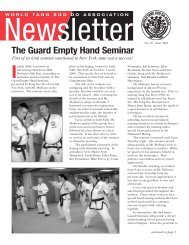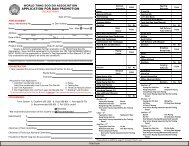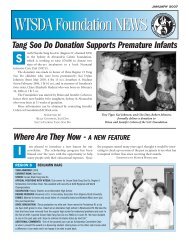June 2012 Masters Profile - The World Tang Soo Do Association
June 2012 Masters Profile - The World Tang Soo Do Association
June 2012 Masters Profile - The World Tang Soo Do Association
- No tags were found...
You also want an ePaper? Increase the reach of your titles
YUMPU automatically turns print PDFs into web optimized ePapers that Google loves.
<strong>June</strong> <strong>2012</strong> <strong>Masters</strong> <strong>Profile</strong>Name: Robert E. BeaudoinRank and date of rank: Pal Dan - July, 2010Region and Studio Name & Location: Region #9 - Academy of Karate, Inc.,Waterbury, CT 06705Contact Information: 80 Pineridge Drive, Wolcott, CT 06716 - email:rbeaudoin05@snet.netPersonal InformationWhere were you born?Cincinnati, OhioDescription of profession or trade outside of <strong>Tang</strong> <strong>Soo</strong> <strong>Do</strong>:Training Consultant & University Professor (Retired)List your academic accomplishments, military service:BA, MA, Ed. D; USAir Force (4 years)Martial Arts CareerWhen, where and why you started <strong>Tang</strong> <strong>Soo</strong> <strong>Do</strong>?I started <strong>Tang</strong> <strong>Soo</strong> <strong>Do</strong> in May, 1962 at the <strong>Tang</strong> <strong>Soo</strong> <strong>Do</strong> gym on the Osan Air Base in Korea under Mr. Jae C. Shin. Wetrained every day from 7-10 PM on base and sometimes on Saturday in village outside the base.What were your first impressions when you started and how have they changed?My first impressions were long classes, mixed ranks, brotherhood, and respect. I really didn't realize the depth andconnection to everyday life that the <strong>Tang</strong> <strong>Soo</strong> spirit and training could impact. I became more aware of that connectionwhen I starting to teach <strong>Tang</strong> <strong>Soo</strong> <strong>Do</strong> to others about a year later.Any other martial arts studied?I visited a Judo school in Korea, which appeared interesting, but less challenging. I also visited a Hapkido school butfelt too challenged and less friendly. When visiting Mr. Shin's school, I felt welcomed, challenged, and becameenthusiastic to learn. After one year training with Mr. Shin, a 3rd Dan at that time,and several other Korean masters, Itested for my 1st Dan on May 12, 1963, at Inchon Korea. One other American, Bob Shipley, tested for 2nd Dan, and twoother men, Ray Avery and Barney Miller, tested with me for 1st Dan. That was 49 years ago. <strong>The</strong> only other formaltraining in martial arts was for two summers (two months each), while attending University of Sarasota for mydoctorate in education. I was nominated to test for a 1st Dan in Hapkido under Dr. Jung Hwan Park. However Ideclined, feeling no need to acquire official rank since I just needed a place to train while attending school.1 of 4
Grandmaster Beaudoin stretching with his class.<strong>Tang</strong> <strong>Soo</strong> <strong>Do</strong> CareerWhat was your Master’s thesis on, why did you choose it, and what did you learn from it?Several of my thesis topics included the title of "Leadership". <strong>The</strong>re were always specific chapters within GrandmasterShin's books that required leadership insights and explanations and I was honored to make contributions to those.Besides researching concepts and expressions of "Leadership", I applied my personal experiences as an educator ofstudents, clients, and the general population towards the development of personal and professional leadership.What is your favorite part of <strong>Tang</strong> <strong>Soo</strong> <strong>Do</strong>?After presenting a clinic, teaching a class, demonstrating a technique, performing a hyung, or giving a lecture, I see andfeel the gratitude, admiration, and developed confidence acquired by the student, learner, parent, or spectator. At theend when emotionally drained, physically exhausted, knowing that I gave it my all, their faces and smiles show it, that'smy favorite moment.WTSDA committees or positions:Secretary General, Chair of Development Committee of the Technical Advisory Committee.Who are some of your role models in and out of WTSDA?Mother <strong>The</strong>resa, Abraham LincolnWhat are some of your favorite memories of your time in WTSDA?I have several favorite memories that include: (1) In 1984, the first WTSDA China Delegation contained only five of us.<strong>The</strong> personal time I spent with Grandmaster Jae C. Shin after we finished our three week historical mission wasmemorable. We were totally exhausted, but just the two of us took a walk around Hong Kong harbor, sightseeing andsome shopping. (2) In 1976 before 2000 spectators, Grandmaster Hwang Kee, <strong>Masters</strong> Shin, Kim, Hwang, a few othermasters, I performed one of my "Yin & Yang" -"Fire and Ice" break demonstration during one of my tournaments. Itconsisted of breaking seven boards, lit on fire, (soodo kong kyuck) followed by breaking two 150 pound blocks of ice,(also with a soodo kong kyuck). (3) And the most recent favorite memory is being a part of Grandmaster Shin's 9th Danpromotion, including Mrs. Shin putting his belt on, taking off his old belt and giving to their son, meditating to the ninegongs, and presenting masters' promotions for the first time.What is your favorite Hyung and/or weapon and why?Several forms are my favorite. <strong>The</strong> Pyung Ahn Forms are special, hence the meaning of Pyung Ahn, calm and peaceful.2 of 4
My favorite among those is Pyung Ahn Sah Dan, I like those side kicks. Bassai is also special, since it is the formrequired to test for 1st dan, and I remember Grandmaster Shin telling me while preparing to test for 1st Dan that Ishould do the hyung 100 times to get ready to test - that included dreaming about it and picturing it in my mind. Morerecently, I enjoy our last hyung, Sae Kye Jang Kwan, 99 moves, and sharing it with our fellow senior KoDanJa. As for afavorite weapon, my favorite is now the spear. Known as T'e He Chiang, the shooting gun spear form is king of theweapons and is perhaps one of the oldest weapon of humanity.Difference between when you first started training and today?One of the biggest differences in training has been the division of classes according to ranks and ages. In the beginning,there may have been three hour classes, consisting of mostly adult men, with beginners and advanced students, andchildren and adults together. Due to time constraints and family involvement, classes became separated according toages, ranks, and specialized topics. In many ways, the quality of instruction has improved.As WTSDA celebrates its 30th anniversary, what are your hopes/wishes for WTSDA in the next 30 years?It is my hope that the next 30 years bring a steady and abundant growth of our WTSDA. Being the optimist, I can easilyforesee reaching 1million in 10 years, 5 million in 20 years, 10 million in 30 years. We have already entered the youthand younger members of the family aspect of our population. <strong>The</strong>re is an untapped segment of the elderly and olderparents that need attention, specialized <strong>Tang</strong> <strong>Soo</strong> <strong>Do</strong> curricula, and perhaps a blending of KiKong and Traditional <strong>Tang</strong><strong>Soo</strong> <strong>Do</strong>.Advice/Words of WisdomYouth, teen and/or adult martial artist:Working with Tiny Tigers(1)Youth - Dream your dreams, be not afraid, look to nature to seek self-expression, use the gift of discipline, seekcourage, show respect to self and others, smile with peacefulness in your heart.(2) Teens - If you seek success, pursue it, which means you have to be willing to work hard to achieve. Seek instructionand guidance. Hard is not impossible. Believe in yourself.(3) Adults - <strong>Tang</strong> <strong>Soo</strong> <strong>Do</strong> is ageless, no such thing as "too old". You're never too old to learn. Our body may havelimitations, so does our mind, but we can still make improvements for both. A healthier mind, body, and spirit are greatrewards and well worth the effort. Simply, just do your best.Teaching tips or ways you make classes more exciting:<strong>The</strong> best <strong>Tang</strong> <strong>Soo</strong> teachers have knowledge in their mind, strength in their kihap, compassion in their eyes, and love in3 of 4
their heart.Boo Kwan Chang Nim Beaudoin with a ceremonial drum (left) and with Kwan Chang Nim Shin at the 2010 <strong>World</strong> Championship(right).4 of 4






